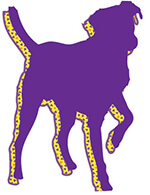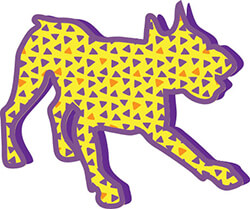
“Wait!”: A Simple Cue for Boarding and Daycare Dogs
By Kama Brown
Training dogs to “wait” in a boarding and daycare setting can be a fun way to impress clients and keep employees entertained. While it may seem like a small task, training the wait cue is a great break in routine for many dogs and their daycare handlers. The wait cue features a unique safety aspect as well, since dogs are learning not to rush at employees. It’s relatively simple, but there are a few variances to keep in mind. Dogs can be trained to wait for the opening of a door or for the chance to have a toy or treat.
“Wait For Food”
When a dog is alone in their kennel, the easiest way to train “wait for food” is with their daily allowance of food.
During the first session, set the dog’s food bowl outside the front of the kennel run. The dog will usually be excited and try to paw at the bowl through the kennel. When the dog realizes this is futile, he will stand, sit or lie down and stare at the bowl. When the dog does any of those behaviors, say, “wait” and then give the dog the bowl of food.
If upon opening the kennel door, the dog tries to shove through to the food, this behavior is a separate type of “wait” that needs to be trained in another session. If you try to train “wait for food” and “wait at opening of door” in one session you will usually see frustration behavior from the dog.
Even though it is not ideal, if the dog has waited for the food by offering a sit, stand or down, open the door slightly and slide the bowl into the kennel past the shoving behavior until you can train “wait for door.”
Alternatively, if the kennels are open on the top, throw some food towards the back of the kennel, then while the dog follows the food, open the door and slide the bowl inside.
During the second session, set the dog’s food bowl outside of the kennel, this time waiting for a more purposeful, relaxed, or longer duration of sit, down, or stand. Slide the food bowl in again. Repeat this for 2-3 sessions.

During the fifth session or so, place the food bowl in the same spot, this time when the dog offers the “wait for food” behavior, open the dog’s kennel door. Opening the door will usually elicit the dog to stop waiting. Standing still, with the door open only far enough so the dog cannot run past your body, say “wait” and stand still until the dog offers the “wait for food” behaviors they previously offered, whether that be sit, down, or stand.
After repeating this session a few times, the dog should wait while you lower the bowl to the ground. If at anytime while bending down, the dog leaves “wait for food” position, such as going from a sit to a stand, or from a stand still to a walk forward, stand back up and wait for the dog to resume the wait position again. Once the dog has mastered waiting while you lower the food to the floor, you can begin to say “okay! Get it!” as a cue that they may have their food.
“Wait At Door”
I’ve found the easiest way to train “wait at door” in a kennel setting is to close the door when the dog pushes forward and open the door when the dog is waiting.
The key is to watch for slight movements. When four feet are still, that is the behavior you want and the dog should be rewarded by being allowed out of the door. During the first few sessions, being allowed out after just waiting for 4-5 seconds is ideal. Remind employees to only work up to about 10 seconds. In a boarding and daycare setting, employees shouldn’t be waiting all day for dogs to wait! A 10 second wait ensures the dog is not barging at the kennel door, which is the true safety goal.
Sometimes this becomes a bit of a trial and error learning session but the dog usually picks up the idea quickly. A dog may act still and then lunge at the last second. Or they may not care at all and refuse to come out of the door once it’s open. Slamming the door to purposely scare the dog is not recommended and could create aggression towards handlers. Calmly open the kennel door slightly and slowly while the dog is not moving forward towards it and close it slowly if the dog takes a step forward. Once the dog is still and not moving towards the door, quickly open the door and let them out.

Groups of Dogs
Training wait at the opening and exit door of the daycare yard is a fantastic and fun way to create a bit less chaos. Once the routine is established, new dogs usually catch on quickly. Using the same idea as the “wait at door” routine for a single dog in a kennel, watch for slight movements.
With the group of dogs facing you at the entrance/exit, stand so your body is blocking the door opening. Slowly open the door slightly and look for a dog whose four feet do not move. After only just a second or two, call that dog over and let them through the door. You can give a treat on the other side of the door, once they’ve gone through and are not around other dogs. If someone else is there, moving dogs into their kennels, continue giving a treat to each dog as they come through. If the dogs were doing a wait on one side, only to be grouped again on the other side, avoid the treats.
Repeat the sequence again, only opening the door slightly, looking for a dog whose four feet do not move. Call that dog by name and allow them through the door. Continue this until all the dogs are out of the yard. After a few days, repeat dogs will understand quickly and begin to wait right away. The more excitable dogs will get the time they need to calm down while you are letting the other dogs through, since it can take a few minutes to let the dogs through one at a time.
The goal is not a prolonged wait since this would cut into employee work time but the dogs can easily learn to wait as long as you need for demonstration purposes. Just keep in mind how long you want them to wait and practice accordingly for a few days for that amount of time.
Since arousal can be extremely high while dogs are being put into the daycare yard, I do not practice wait while entering. Groups of dogs, taken from kennel confinement, then huddled together, trying to get something they want (like into the yard of freedom) can create aggression between the dogs.
Fearful and Shy Dogs
When training “wait” with a fearful or shy dog, it’s important first to get them walking towards employees with confidence. One way to achieve this is by throwing high value treats, such as boiled chicken cut into cubes, towards the back of their kennel run whenever approaching them. The pressure is off for them to run and hide because they now have a distraction to engage them. Once the dog has eaten, they now have the option of approaching or staying in the back of the run. Whenever they approach, even just a step or two, throw another small cube of chicken towards the back of the kennel. After a few sessions, the dog will begin to approach confidently and will be ready for the regular “wait” protocol.
Reactive and Aggressive Dogs
Oddly enough, this same “pre-protocol” that is used for shy dogs can be adapted easily to dogs displaying aggressive kennel behavior. The only difference is that instead of waiting for the dog to fully approach the front of the kennel, throw the food when the dog is still a few feet back.
For example: Approach the kennel and throw the cubed chicken towards the back of the kennel, then when the dog begins to approach again, say “wait” or “stop” and throw the chicken behind the dog, so the dog must turn around and walk away again. This will give the kennel employee a 3-foot safety net to open the door and slide the food in.
If the dog doesn’t notice the chicken, allow them to sniff the bowl of cubed chicken through the closed kennel door before throwing a piece of it.


